The Best Vegetables for Canning (Including Detailed Instructions)
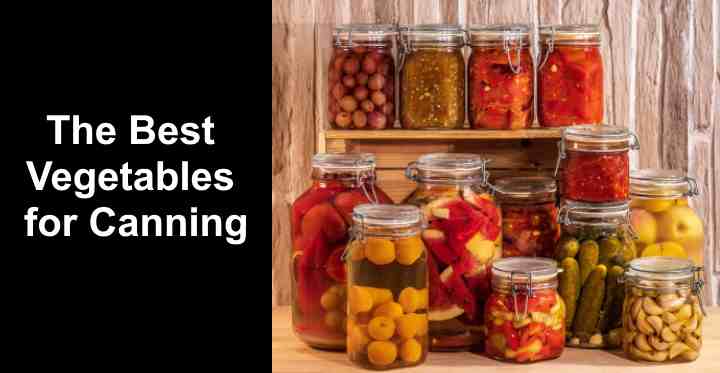
Canning vegetables is a great way to preserve freshness and enjoy healthy, tasty food all year round. Preserving vegetables in jars or cans involves preparing the produce and using a water bath or pressure canner to preserve them. However, not all vegetables are suitable for canning. Therefore, knowing the best ones to preserve in cans is key to successful canning.
Canning has been a popular food preservation method for centuries. Before the days of refrigerators and freezers, people would spend time in late summer and fall canning vegetables. This would extend their veg crop through winter and the following spring, allowing them to enjoy nutritious food throughout the year.
Whether you’re a beginner or an experienced canner, knowing the best vegetables for canning makes a significant difference in the quality of your preserved produce.
This article explores a variety of the best canning vegetables you can grow in your garden. You’ll also get handy tips on the canning process to prevent spoilage or harmful bacteria from contaminating your favorite home-canned produce.
Safety First When Canning Vegetables
Before preparing your favorite vegetables for canning, understanding safety in the canning process is vital. Low-acid foods like vegetables require appropriate processing to prevent dangerous bacteria, germs, and mold from forming. Some canned vegetable contaminants like mold are visible, whereas other potentially deadly bacteria are invisible.
Understanding Clostridium botulinum
The bacterium Clostridium botulinum can form in canned vegetables if you don’t follow the correct procedures. According to the CDC, “home-canned vegetables are the most common cause of botulism outbreaks in the U.S.” This applies to incorrect canning methods when fermenting, canning, or preserving foods in jars.
The Clostridium botulinum bacterium becomes harmful in a moist, low-acid, oxygen-free environment, or a partial vacuum. Such conditions are commonly found inside jars of canned vegetables. The bacterium can grow in canning jars and produce potentially lethal toxins affecting humans and animals that ingest it.
To ensure that all traces of Clostridium botulinum are destroyed, it’s essential to process low-acid foods such as vegetables in a pressure canner for the correct amount of time in temperatures at least 240°F (115.5°C) to eliminate the risk of botulism.
Pressure Canning or Water Bath for Canning Vegetables
Pressure canning and a water bath are two ways to preserve food. However, water bath canning is unsuitable for preserving low-acid vegetables, including tomatoes. You should only use the water bath method for vegetables high in acid or pickling vegetables. This is because adding vinegar makes vegetables highly acidic and safe for processing in a water bath canner.
The pressure canning method is the only way to preserve low-acid foods safely. The canner uses high temperatures and steam pressure to kill traces of Clostridium botulinum and seal jars hermetically. This is the only method to reach temperatures above boiling point and eliminate harmful microorganisms in low-acid foods.
Tools For Safely Canning Vegetables
Canning equipment involves a pressure canner or water bath for canning popular vegetables. A pressure canner is for low-acid vegetables, and a water bath canner is for pickling. Other useful tools include a food thermometer, a canning rack, jars and lids, and a canning funnel.
Pressure canner

A pressure canner is a large and heavy pot with a tight-fitting lid. The canner should have an exhaust vent or petcock—a safety valve—and an accurate pressure gauge. The pressure canner should have a metal rack at the bottom to prevent jar breakages. It should also be large enough to hold at least four one-quart jars.
Water bath for canning

A water bath canner is a large pot with a fitted lid, a rack to keep jars elevated, and a thermometer. The heated water creates a hot, uniform environment, effectively sterilizing jars and ensuring the safe canning of high-acid vegetables.
Food thermometer

A food thermometer is crucial for ensuring food safety when canning. It’s vital to monitor temperatures during canning and pickling to be sure adequate heat destroys harmful microorganisms and helps prevent foodborne illnesses.
Filling jars
A few extra pieces of equipment can be helpful when filling jars with vegetables for canning. These include spatulas, a canning funnel that fits jar openings, and a jar lifter. Citric acid or lemon juice can also be added to canning recipes to make the process safer.
Two methods to fill jars include the hot pack method and the raw pack method.
Hot pack method: This canning process involves blanching or cooking vegetables for a set amount of time before packing them into hot jars. Usually, boiling liquid is added to help remove air from the product, enhance jar filling, and ensure proper heat penetration during the canning processing.
Raw pack method: This canning method involves packing raw vegetables tightly into a jar and filling the jar with boiling water. Before canning vegetables with the raw pack method, check if they are suitable for raw canning.
Pickling Vs. Canning – What’s the Difference?
Pickling involves preserving foods using an acidic medium, such as vinegar or a saltwater brine, which imparts a tangy flavor to the food. It’s commonly used for vegetables, fruits, eggs, and certain fish.
Canning, on the other hand, involves heating food in jars or cans to destroy microorganisms, then sealing it to prevent spoilage. This method aims to maintain the original flavor and texture of the food and can be used for a wide range of items, including fruits, vegetables, meats, and prepared dishes.
The Best Vegetables for Canning
Let’s look at some of the best vegetables for canning using the pressure canning method.
Tomatoes (Solanum lycopersicum)
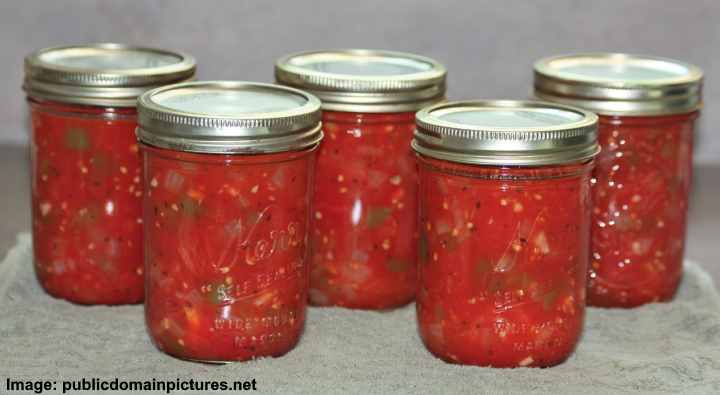
Canned stewed tomatoes
Fresh tomatoes are some of the most popular vegetables for canning. Because tomatoes have a relatively short shelf life, canning is a great way to preserve them. Also, canned tomatoes taste delicious and are the main ingredient of many sauces. Despite being a slightly acidic vegetable, pressure canning is the only suitable method.
Tomatoes are ideal vegetables for canning. For example, the canning process retains key nutrients like lycopene and vitamin C. They also give you a versatile home-grown product to use throughout the year when supermarket tomatoes have lost their taste and nutritional value in winter.
Bell Peppers (Capsicum spp.)
Delicious red, yellow, and green peppers are ideal for pressure canning or pickling. Pressure canning preserves their vibrant color, flavor, and nutritional value. However, it’s important to remember that they will lose their crunch or texture during the canning process. Despite their lack of crunch, canned peppers are still a tasty ingredient in many dishes.
Cucumbers (Cucumis sativus)
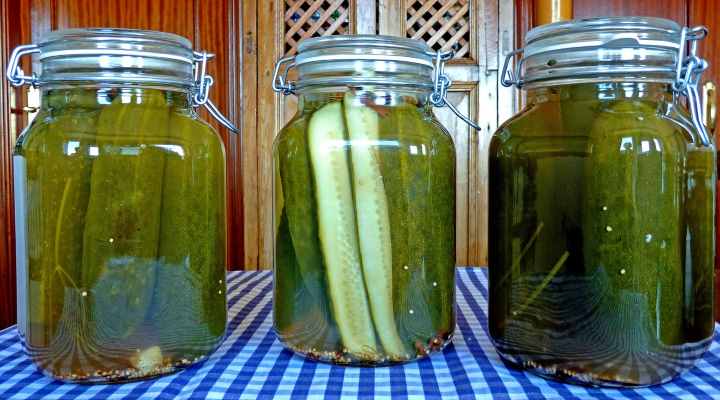
Pickled cucumbers
Cucumbers are a popular vegetable for pickling and canning because they hold their crunch. Pickled cucumbers, or gherkins, have a tangy and refreshing taste you can enjoy on their own or as a condiment.
Pickling allows for a variety of flavors and styles, such as the tangy dill pickles, sweet and savory bread and butter pickles, naturally fermented lacto-fermented pickles, and delightfully sweet pickles. Each type offers a unique twist on the classic preserved cucumber, catering to a wide range of taste preferences.
Depending on your preference, you can pickle small cucumbers whole or slice them first. The traditional way to preserve cucumbers is, of course, pickles. You can make dill pickles, bread and butter pickles, lacto-fermented pickles, or even sweet pickles.
It is also possible to can cucumbers in a brine and vinegar solution. The pickling recipe can also include ingredients like dill, peppercorns, grape leaves, and garlic cloves to enhance their flavor. This helps to preserve their freshness and crunchiness.
Asparagus (Asparagus officinalis)
Asparagus is a tender vegetable you can pickle or can for long-term storage. Pickled asparagus tends to lose its vibrant green color in the canning process. However, it maintains its unique flavor and nutritional value. Also, the pickling process enhances the natural taste of asparagus and creates a tangy, acidic bite.
Canned asparagus is also a convenient option to preserve this delicious vegetable. The fibrous green shoots have a short season and shelf life. Therefore, canning the young shoots lets you incorporate them into dishes like salads, stir-fries, or soups.
To can asparagus, it’s essential to use a pressure canning method due to its low acidity. Start by thoroughly washing the asparagus spears and snapping off the tough ends. Cut the spears to fit lengthwise in your canning jars. Pack the spears into the jars firmly but not too tightly. Fill the jars with boiling water, and remove all air bubbles. Seal the jars and pressure can them for 30 to 40 minutes at 10 pounds of pressure, depending on the size of the spears.
After 24 hours, check that the jars have sealed properly (the lids should not flex up and down when the center is pressed). Store the sealed jars in a cool, dark place. They will keep for up to a year.
Whether pickled or canned, marinated asparagus is a versatile vegetable to enjoy throughout the year.
Carrots (Daucus carota)
Carrots are a versatile perennial vegetable for canning because they retain a sweet, crunchy texture. Although a staple of root cellars, pickling or canning carrots preserves the orange vegetables for many months. Their crunchy taste adds a flavorful element to many dishes. The canning process also helps preserve their vibrant orange color.
Pressure-canned carrots are a convenient option for preserving this nutritious vegetable. By using hearty, robust fall carrots, you ensure they retain their texture. This way, you can use them in various recipes, such as soups, stews, or casseroles.
Pickling is another way to get the most out of this tasty, sweet root vegetable. Whether pickled or canned, carrots are a tasty and nutritious vegetable that can be enjoyed year-round.
To can carrots using both slicing and dicing methods, begin by washing and peeling fresh carrots. Then slice some carrots into thin rounds and dice others into small cubes for a mix of textures.
Sterilize canning jars, lids, and bands in boiling water or a dishwasher with a sterilizing cycle.
Blanch the sliced and diced carrots in boiling water for 3 minutes, then quickly cool them in ice water. Pack the blanched carrots into the sterilized jars, leaving about 1 inch of headspace.
If desired, add a pinch of salt to each jar for flavor. Fill the jars with boiling water, ensuring the carrots are fully submerged and maintaining the headspace. Remove air bubbles, wipe the jar rims, place the lids on, and screw the bands until fingertip tight.
Process the jars in a pressure canner for 25 minutes for pint jars and 30 minutes for quarts at 10 pounds of pressure, adjusting for altitude. Once processed, let the jars cool and check the seals before storing.
Onions (Allium cepa)

Pickled pearl onions
Most varieties of onions can be pickled or canned to extend their shelf life and add flavor to dishes. The best onions to pickle are small red onions or white pearl onions. However, you can also slice shallots, sweet onions, red onions, or traditional brown onions for pickling. The canning process adds sweetness and reduces their sharpness.
Pickled onions have a tangy and slightly sweet taste that can enhance sandwiches, salads, or charcuterie boards.
To pickle onions, you can slice them thinly and soak them in a vinegar and sugar solution. This process helps to preserve the onions and creates a delicious tangy accompaniment to salads.
Pressure-canning onions is another option to preserve them. All you need to do is blanch sliced onions for a few minutes and add to sterilized jars. Then, use the pressure canner to preserve them.
Garlic (Allium sativum)
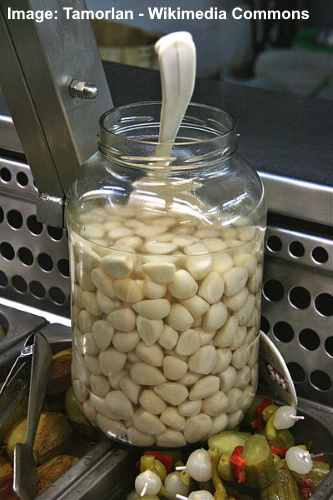
Pickled garlic
Garlic is a popular ingredient for pickling to give it a tangy kick. Unfortunately, canning garlic tends to affect its taste and texture negatively. Scientists say that canning garlic is not recommended due to the fact that long processing times make it lose its flavor.
Here are canning alternatives if you want to store or preserve homegrown garlic:
Drying garlic: You can dry fresh, firm garlic in a dehydrator until it becomes brittle and crisp. Afterward, you can store it in the freezer or at room temperature.
Storing garlic vinegar or wine: You can create a garlic-flavored liquid by storing peeled garlic cloves in wine or vinegar. The acidity of these liquids prevents Clostridium botulinum from developing. It will keep in the refrigerator for up to four months.
Storing garlic in oil: It is possible to store peeled garlic cloves in oil only if you keep them in the freezer. Storing garlic in oil at room temperature or in the refrigerator increases the risk of botulism.
Beets (Beta vulgaris)
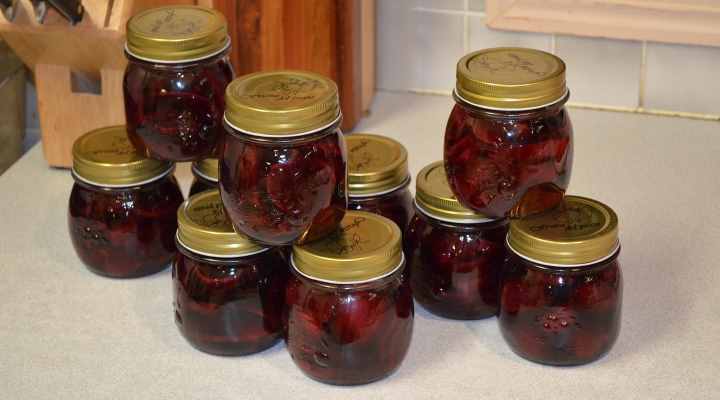
Canned beets
Beets are purple-colored root vegetables that retain flavor, color, and texture after pressure canning. Beets store well in a root cellar along with potatoes. However, canning beets is a great way to preserve their natural sweetness and earthy taste. You can then use the purple roots in various dishes.
Pickling is another way to eat beets. Adding vinegar to the pickling liquid gives them a tangy, sweet flavor. This pairs well with salads and adds vibrant color to make dishes visually appealing.
Ways to use canned beets include the following:
- Toss canned beets in a simple salad
- Combine with chickpeas for a bright pink hummus
- Chop canned beets and use with salty feta cheese for a tasty Mediterranean salad
- Combine beets, quinoa, and roasted root vegetables for a healthy meal
Peas (Pisum sativum)
Peas are a popular yet time-consuming green vegetable for canning. Preserving them in a canner helps retain their nutritional value, shape, and flavor for several months. However, shelling fresh garden peas can take a long time. Like canning asparagus, the canning process tends to mute their vibrant green color.
Canned peas are a convenient way to enjoy this nutritious vegetable year-round. They contain good amounts of vitamin C, vitamin A, and fiber. Although canned peas are not as crunchy as their fresh counterparts, you can use them in soups, stews, and casseroles. They are also easy to puree to create a tasty accompaniment to fish and meat dishes.
When canning peas, it is important to blanch them first to help maintain their texture and quality.
Cabbage (Brassica oleracea)
The best canning methods for cabbage varieties involve fermenting it first to create sauerkraut or kimchi. The process of fermenting cabbage involves soaking shredded cabbage in a brine solution of water, salt, and sometimes vinegar. Lactic acid develops in the cabbage, causing it to ferment.
Once fermented, use a water bath to sterilize and seal the cabbage in jars for long-term storage.
You can also pickle cabbage to store it in jars and extend its shelf life. Pickling cabbage for canning involves marinating in a solution of apple cider vinegar, water, coarse sea salt, and sugar. You can also add other ingredients like shredded carrots and bell peppers to enhance its flavor.
Additionally, cabbage is a nutritious vegetable high in vitamins C and K. Pickling or fermenting does not diminish these nutritional benefits. However, pickled cabbage and sauerkraut tend to be high in sodium.
Okra (Abelmoschus esculentus)
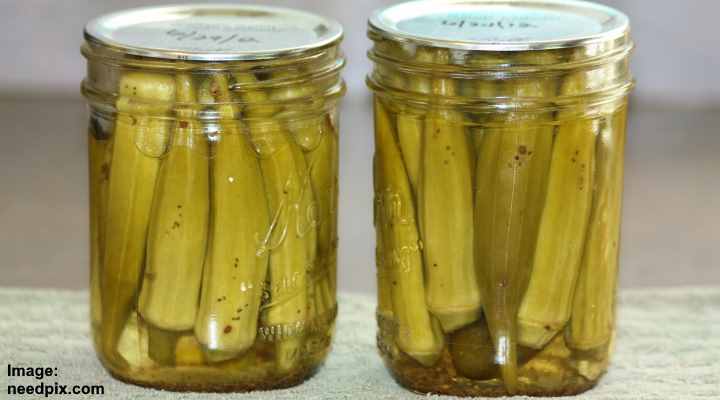
Canned okra
Okra is a vegetable well-suited for canning due to its firm texture and ability to retain its shape and flavor after processing. Canning okra allows you to enjoy this nutritious vegetable year-round, even when it is out of season.
One of the benefits of canning okra is that it helps preserve its nutritional value. Okra is rich in vitamins A, C, and K and minerals like calcium and potassium. By canning okra, you can ensure that these nutrients are preserved and available for consumption even after an extended period of storage.
Canned okra also offers versatility in terms of how you can use it in various dishes. You can add it to soups, stews, and gumbo for a thickening effect and to enhance the flavor. Canned okra can also be breaded and fried or used in stir-fries. Its unique texture adds a satisfying crunch to these dishes.
Furthermore, canning okra allows you to enjoy this vegetable when fresh okra is not readily available or affordable. By preserving it through canning, you can stock up on okra during its peak season and have it as a pantry staple throughout the year.
Overall, the firm texture, nutritional value, and versatility make okra an excellent choice for canning. Whether you want to add it to your favorite recipes or explore new culinary possibilities, canned okra provides a convenient way to incorporate this nutritious vegetable into your meals.
Squash (Cucurbita spp.)
Squash vegetables can be canned for long-term storage. However, the canning or pickling process depends on the type of squash.
Canning winter squash: Late-season squashes such as pumpkin, butternut, acorn, and spaghetti squash need to be preserved using a pressure canner. Before canning, it’s essential to cut the flesh into cubes. Of course, once you open the jars, you can easily mash them into a quick purée if desired.
Canning summer squash: Before home-canning summer squash vegetables—zucchini, pattypan squash, and yellow squash—you must pickle them first. After pickling the squash, you can use the water bath method for canning.
Sweetcorn (Zea mays)
Sweetcorn is a sweet, vibrant yellow vegetable that is well-suited for canning. The canning process locks in the delicious sweetness and vibrancy of yellow kernels. Canned sweetcorn retains some of its crunchiness as fresh corn on the cob. Before pressure canning, it’s necessary to remove the kernels from the cob.
It is important to blanch the corn kernels before packing them into jars when canning corn. This method helps to preserve their texture and flavor. Canned corn is an ideal accompaniment to soups, tacos, burrito bowls, relishes, stews, and casseroles. Canning corn allows you to enjoy the taste of fresh corn even when it is out of season.
Green beans (Phaseolus vulgaris)
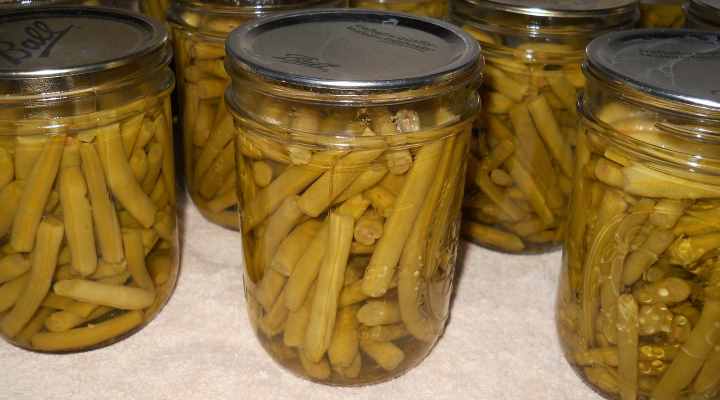
Canned green beans
Pressure-canning green beans is a popular way to enjoy these vegetables long after the season has passed. Like many canned green vegetables, they may lose their vibrancy during the canning process. However, canned green beans are ideal for adding to stir-fries, casseroles, soups, and stews.
It’s good to remember that the canning process preserves the nutritional content of the leguminous vegetables. Therefore, they add fiber, vitamins, iron, and protein to various dishes. For a tangy twist, you can pickle green beans before canning to use as a side dish, on salads, or on a charcuterie board.
Mushrooms (Agaricus bisporus)
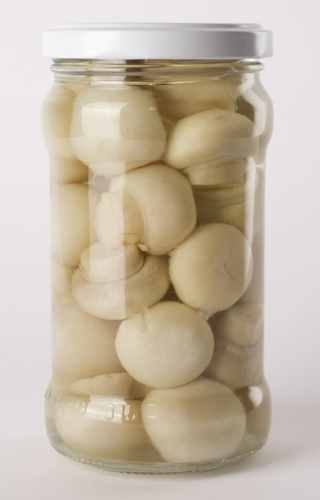
Canned mushrooms
Many varieties of mushrooms can be a delicious and versatile ingredient for pressure canning or pickling.
Canning mushrooms is a great way to preserve delicious fungi, keeping their unique tastes and textures. Before canning, it’s vital to clean the mushrooms to remove dirt, debris, and grit. It’s also vital to find specific canning recipes for the type of mushroom for preservation.
Canned mushrooms have a unique flavor and texture, making them a convenient pantry staple. They are a great option for adding depth and umami to various recipes. It’s easy to add them to soups, stews, pasta dishes, and stir-fries for an earthy and meaty flavor.
Canned mushrooms also have a long shelf life, allowing you to enjoy them even when fresh mushrooms are not readily available.
Note of warning: Some mushrooms can be highly toxic, and incorrect canning methods can cause potentially lethal bacteria to develop. Therefore, never consume fresh, sauteed, or canned mushrooms if you are unsure of the variety.
Parsnips (Pastinaca sativa)
Canning parsnips is a good option if you don’t have a root cellar at home. The best canning method to ensure long-term storage is the pressure canner. Choose small to medium parsnips, which are sweeter, and hold their flavor better. For the best canning results, you must cut the parsnips into uniform chunks.
Canned parsnips retain their natural sweetness and tenderness. They are then easy to use in various dishes like soups, stews, or roasted vegetable medleys throughout the year. As with all canned vegetables, the process helps lock in nutrients and flavor.
Sweet Potato (Ipomoea batatas)
Pressure-canning sweet potatoes or yams is a great way to preserve the nutritious root vegetable for many months. Because they are not starchy vegetables, they retain their texture and shape during the canning process. The best process is to raw pack them to ensure they taste delicious. However, the hot pack method means more veggies in the jar.
The National Center for Home Food Preservation recommends canning sweet potatoes in water or syrup. Although water is a healthier option, the yams may taste bland afterward. Also, removing the skin and cutting the orange root vegetables into medium-sized chunks is necessary.
Canned sweet potatoes are ideal for adding natural sweetness and texture to recipes like casseroles and pies or as a side dish.
Turnips (Brassica rapa subsp. rapa)
Turnips are root vegetables you can preserve through pressure-canning. Unfortunately, the hot pack canning process causes turnips to develop a particularly strong flavor and become discolored. However, you can add the nutritious canned vegetables to stews, casseroles, and soups where their flavor, color, and texture won’t be an issue.
Potatoes (Solanum tuberosum)
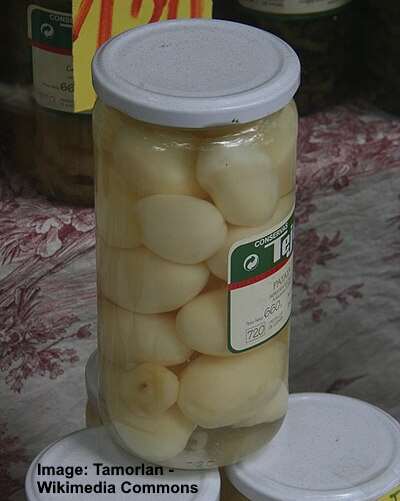
Canned new potatoes
The best potato varieties for canning are small, waxy tubers with low starch levels. Canned new potatoes tend to have a delicious flavor, and they hold their shape well. On the other hand, chopped large potatoes don’t can well because they lose their shape and become mushy.
However, canning isn’t the typical recommended method for preserving potatoes. The traditional way to store potatoes through the winter is to keep them in a dark, cool, dry place with good ventilation.
Other methods to preserve potatoes include the following:
- Dehydrate potato slices to create crispy potato chips or rehydrate them when you want to use them.
- Freeze slices of potatoes by blanching or semi-cooking them first to preserve their color and texture.
Cauliflower (Brassica oleracea var. botrytis)
Cauliflower is not the best vegetable for canning as it develops an unpalatable flavor. Instead, it’s best to pickle the white florets before preserving them in a jar. To successfully pickle cauliflower, it’s necessary to remove the stems and separate individual florets by hand. Pickled cauliflower retains its texture and adds a zingy taste to salads and snacks.
Zucchini (Cucurbita pepo)
Zucchini is a versatile vegetable that is best preserved in jars by pickling. The approved canning method for zucchini is pickling the vegetable or using an acidified recipe for canning in a water bath. Unfortunately, the delicate zucchini flesh falls apart in a pressure canner, making it unsuitable and unsafe for canning.
Using a pressure canner to preserve zucchini together with chunks of tomatoes is possible. The tomatoes add some acidity and prevent the zucchini flesh from becoming overly mushy. This vegetable preserve is great for adding to pasta dishes and soups. However, it’s vital to find a tried and trusted recipe.
Olives (Olea europaea)
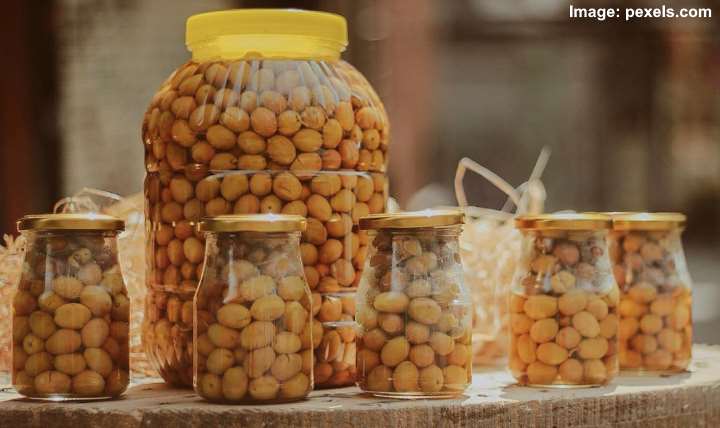
Jars of pickled olives
Olives can be a tricky food to pickle or can because they require curing in brine beforehand. The brining process can take several months and requires changing the brine every 14 days. This process is required to extract the bitterness from these popular black or green drupes.
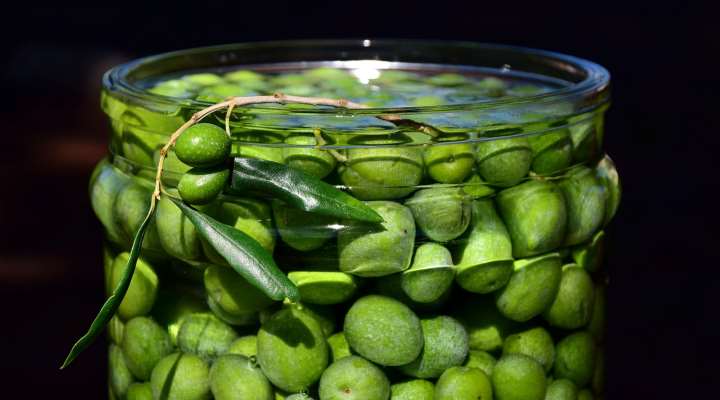
Olives in brine
When pickling olives in brine, you can add extra flavors with various herbs and spices for added taste. Once pickled, you can use a pressure canner and hot pack the prepared olives to preserve their tastiness. If you have easy access to fresh olives off the tree, canning or pickling can be a great option to preserve them.
However, it’s good to note that olives are too bitter to eat straight from the tree. Therefore, it’s vital to pickle them in brine before consuming them.
Hearts of Palm (Bactris gasipaes)
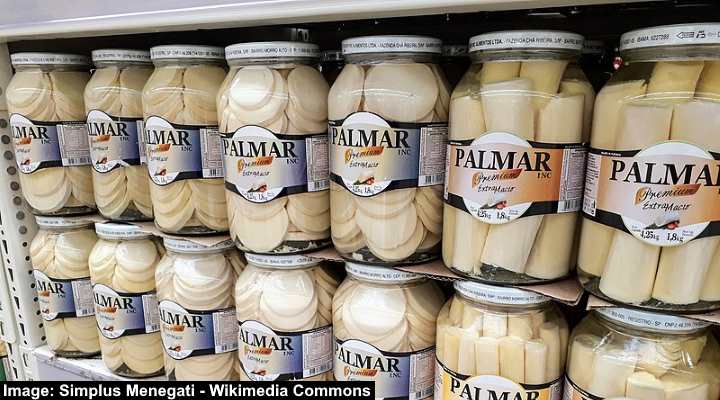
Canned hearts of palm
The center of a palm tree—hearts of palm—is a unique vegetable for canning or pickling. The hearts of palm have a tender, creamy texture, and delicate flavor in canning preserves. To get the core, cutting the entire trunk and removing the bark is necessary.
Canned hearts of palm taste like artichoke hearts with a crabmeat texture. After canning, hearts of palm are popular ingredients in salads, stir-fries, and side dishes. They are also delicious when grilled with lemon zest, garlic, and paprika as a vegetarian seafood alternative.
Artichoke Hearts (Cynara cardunculus var. scolymus)
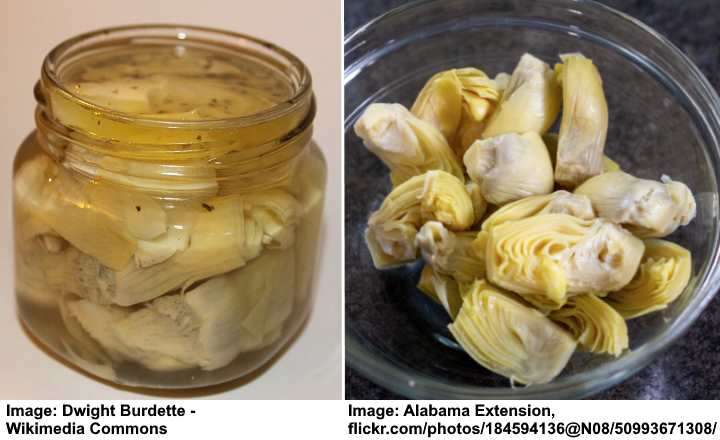
Canned marinated artichoke hearts
Artichoke hearts are a unique and flavorful vegetable that tastes better after canning. Canned artichoke hearts are a great pantry staple to have on hand throughout the year. For canning, it’s necessary to peel the artichoke stems and remove the hard outer leaves. Rather than pressure-canning, most people pickle the delicious vegetables before storing them in jars.
Canned pickled artichoke hearts are a delicious addition to salads and pasta dishes. You can also eat them on their own as a flavorful appetizer. They are also a great topping for pizzas or added to dips and spreads for an extra flavor.
You can also preserve artichoke hearts in brine to avoid a sharp vinegar taste. However, you should source a trustworthy recipe for preserving artichoke hearts in brine before canning in a water bath.
Celery (Apium graveolens)
Celery is not commonly canned because it tends to lose its texture and become mushy. However, you can pickle the crunchy vegetable to extend its shelf life. Also, dehydrating celery is another way to make it last longer. You can then add it to sauces and stews to add a crunchy element to dishes.
Water Chestnuts (Eleocharis dulcis)
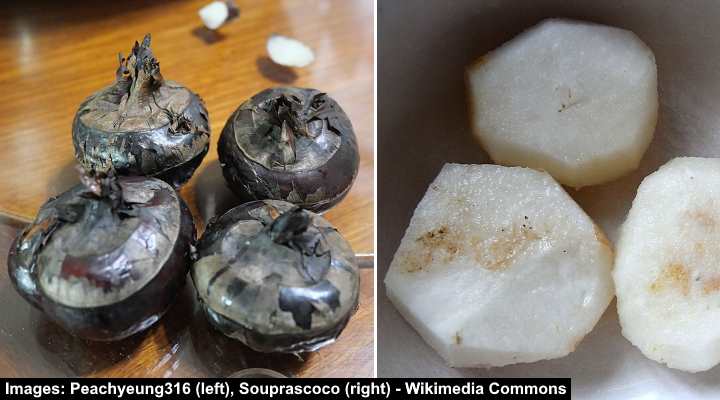
Unpeeled and peeled water chestnuts
Water chestnuts are crunchy vegetables often available in cans. Canning the delicious aquatic vegetables retains their crunchy flavor, which is often a staple in Asian cuisine like stir-fries, salads, and other dishes. The canning process preserves their unique texture and mild, slightly sweet taste. They go well with ginger, bamboo shoots, snow peas, and coriander.
Despite the availability of canned water chestnuts in stores, few recipes exist on how to can them at home.
Frequently Asked Questions about Canning Vegetables
Here are answers to some questions many people ask about canning vegetables at home.
What vegetables cannot be canned?
Some vegetables, like zucchini, lettuce, cabbage, Brussels sprouts, broccoli, and artichokes, become mushy when canned. Therefore, it’s usually necessary to pickle or ferment them before canning. You must use a pressure canner to process all low-acid vegetables due to the risk of botulism.
Can I preserve tomatoes in a water bath canner?
You can use a water bath for canning tomatoes or tomato-based products like salsa. This is due to their acidic content. However, the recipe should include extra acidity, like lemon juice, to prevent bacterial growth. However, it’s best to use a pressure canner for canning tomatoes, as not all tomatoes have the same acidity levels.
How do I know if a recipe is safe for canning?
Ensure the recipe comes from a reliable source. For example, the USDA publishes guidelines on canning vegetables, tomatoes, red meat, poultry, and seafood. Always follow tested and approved recipes, as they specify proper processing times, acidity levels, and other safety measures to prevent the risk of foodborne illnesses.
How long will canned food last?
When stored properly in a cool, dark place, canned food can last up to one year or longer. However, it’s recommended to consume canned vegetables within a year for optimal quality and safety. Never consume canned vegetables or other foods from dented, cracked, bulging, or leaking cans.
Are raw vegetables OK for canning?
It is possible to preserve raw vegetables using a pressure canner. You should tightly pack the jar with fresh, unheated vegetables. Then, add boiling water to the jar, leaving the recommended headspace between the jar rim and the liquid. Lastly, process the mixture in a pressure canning device as per the recipe.
Can I can vegetables without salt?
Salt is not necessary for the canning process. While salt enhances flavor, it is not necessary for safe canning. Therefore, you can omit or reduce salt in canning recipes without compromising safety. However, always follow tested recipes, adjusting salt levels according to personal preference.
However, do not eliminate salt entirely if the recipe specifies it is for safety reasons.
What vegetables are for canning in a water bath?
Water-bath canning is a method of preserving highly acidic food. These include some tomato varieties, berries, fruit, sauerkraut, and pickled vegetables. Therefore, water bath canning is only for making jams and jellies and canning vegetables that have been pickled. The foods’ natural acidity and boiling water bath help preserve them safely without using high pressure in a canner.
Related articles:
